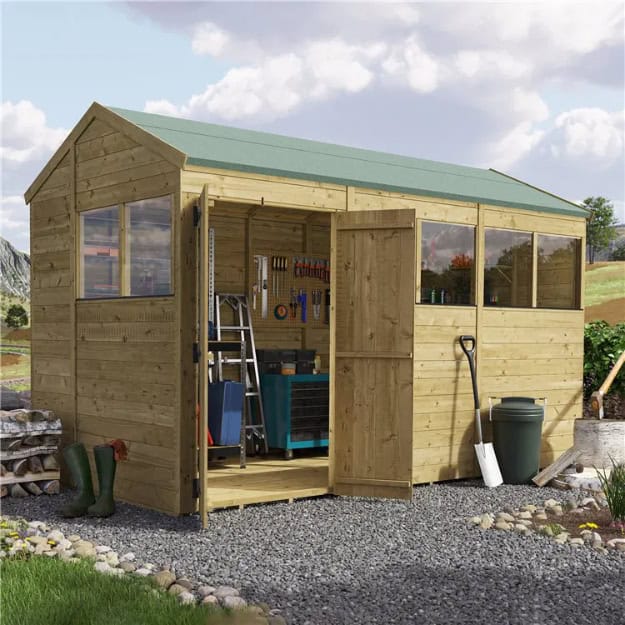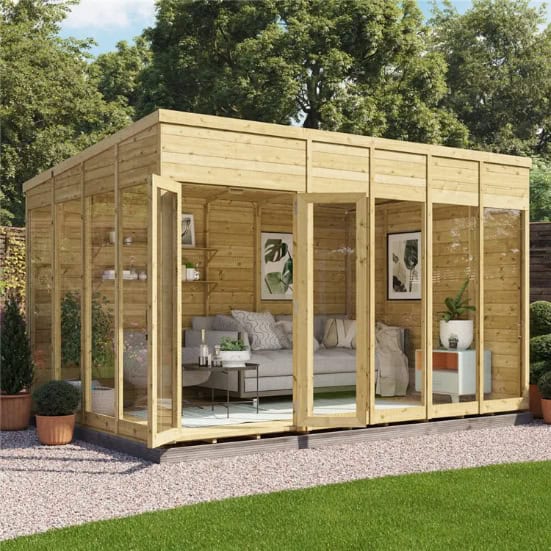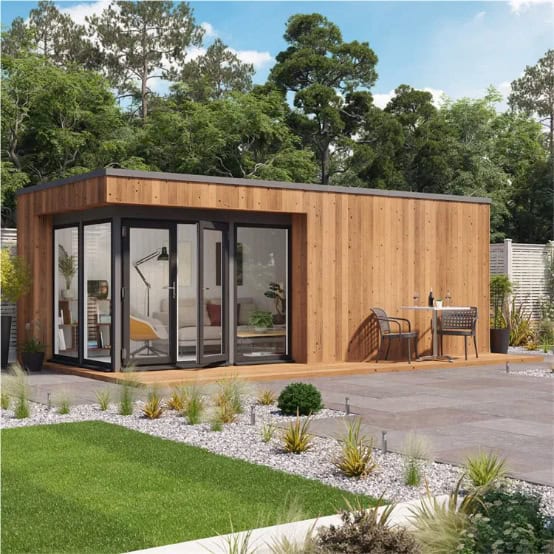Jump to:
Getting a wooden garden building is an investment that needs care, not only when it’s new but over the long haul. And here’s a secret: if you start a simple maintenance routine early on, it’ll be much easier to keep it in top shape over time. Let’s go over the basics so you know what to do – and what to avoid.
Dos for Your New Wooden Building

Here are the best practices for keeping your wooden building in good condition and making it last longer. This applies whether you have a wooden shed, log cabin, or summer house.
Give it the time to flex into shape
Wood can expand, contract, or shift due to temperature, humidity, or moisture changes. So, let your timber garden room adapt before making any modifications or additions—at least a few weeks to a couple of months.
A good sign that your building has settled in is when the walls and roof are straight and level, without gaps or bulging. The doors and windows should also be free of cracks or splits. If all this checks out, it’s ready for some enhancements.
Apply the proper treatment for wood protection

Wood treatment is recommended to protect the timber from moisture, sunlight, and rain exposure. This is particularly true if you’ve built a summerhouse or garden storage from scratch using non-treated timber.
Among the commonly reached treatments are wood preservatives that prevent rot, mould, and insect damage. Wood stains are best applied after the preservatives have fully dried. They offer extra protection against moisture and UV damage while enhancing the wood’s appearance. Stains give the wood a semi-transparent colour while letting its natural features, like grain and colour, show through.
Most wooden garden buildings are sold pre-treated using three methods. Be sure to check the timber treatment details for the one you’re buying. To learn more, read our guide, ‘Pressure Treated vs. Dip Treated Wooden Buildings.’
Note: As a biodegradable material, leaving it untreated will cause it to succumb to rot and deterioration. Worse still, insects, mould, and fungi will feast on it, and this infestation can lead to costly repairs or replacements.
Paint it for a nice finish and more weather defence

Painting is a great way to protect your wooden facade while adding a hue of warmth or brightness. The pigments in the treatment help fortify your timber structure from UV damage, much like sunscreen. The best part? You can choose a colour that matches your garden’s aesthetic—as long as it’s suitable for outdoor buildings.
Exterior acrylic paints offer good protection against moisture and intense sun damage. Oil-based options provide a tough finish and excellent adhesion, though they take longer to dry. For more inspiration, check out ‘The Best Paint Colours for a Garden Shed.’
Tip: If you’ve applied a preservative and/or stain, it’s best to wait until the treatment is fully cured. This can take anywhere from a few days to a couple of weeks, depending on the product and weather. Always refer to the manufacturer’s instructions for drying times. If pressure-treated, the waiting times can be longer (more on this later).
Don’ts for Your New Wooden Building
Steer clear of these mistakes when caring for your investment. It’s just as important as knowing the dos mentioned above. All of these will void the BillyOh Guarantee.
Too close to the walls or fence is a no-no
Don’t position your garden building too close to a wall or fencing, as this will restrict airflow and trap moisture. It will also be challenging to get around it and carry out maintenance and repairs when needed. Experts suggest leaving at least 24 inches around, with 2 feet to spare if possible. This will make it easier to make changes or take on tasks in the future.
You’ll also want to avoid placing your wooden building near trees, especially pines and birches. They tend to sweat in hot weather, releasing moisture into the air. That moisture can settle on your structure and lead to dampness.
Don’t place it directly on the ground
Placing your wooden building on soil or any surface which can get wet isn’t a good idea. For one, the timber floor might soak up moisture. If the ground shifts, it could throw off the stability of the whole structure. And let’s not forget that damp conditions can attract insects and rodents.
To avoid these issues, the building must be on some form of raised base, or pressure treated bearers. You can create a base using skids, bricks or paving blocks for better drainage and ventilation. Here’s a guide on ‘How to Build a Shed Base’ to ensure your investment remains solid year-round. These steps apply to most wooden garden buildings.
The only exception to this is our wooden greenhouses, which can safely be placed on any solid level surface (although you can put them on a base if you wish).
Avoid painting it too soon (especially if it’s pressure treated)
Painting it too soon can do more harm than good. The timber may decay and deteriorate much faster. It can also cause the boards to warp, and you risk major paint adhesion issues or peeling.
Pressure treated sheds, for instance, need to be dry out or be seasoned or cured before they can be primed or painted. This takes about 3 to 4 months or longer during winter—up to 6 months before the moisture levels drop. After a few months, give it a moisture test by sprinkling some water on the surface. If the water soaks into the wood, it’s ready to coat. If the water beads up and doesn’t absorb, it needs more time.
Painting a pressure treated log cabin or other building too soon can cause the treatment to be unable to dry, which will cause rot rather than prevent it. Unsightly orange splotches appearing through the paint are a common symptom of this.
Give this guide a read for more tips: Can I Paint Pressure Treated Wood?
Round-up
These are just a few dos and don’ts to keep in mind, but they’re a great starting point for maintaining your wooden building in the long run. Don’t overlook them, especially the no-nos, to avoid voiding your BillyOh 10- to 15-year guarantee.
To enjoy that warranty coverage, consider our range of garden buildings—you’re sure to find what you’re looking for! Up next on your reading list: How Long Does a Wooden Shed Last?





